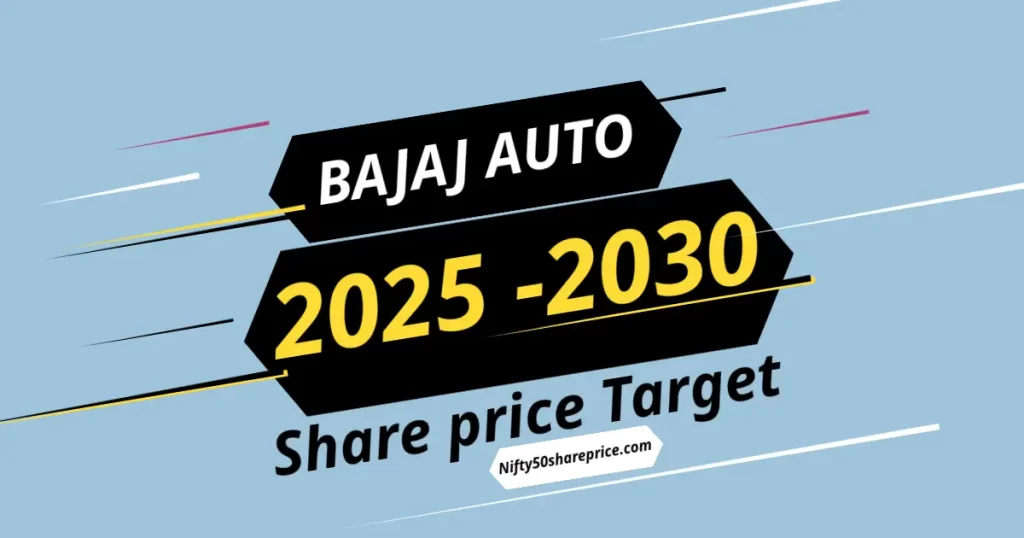Bajaj Auto Share Price Target 2025 to 2030: Bajaj Auto is one of India’s largest two-wheeler and three-wheeler manufacturers, known for its iconic bikes like the Pulsar, Avenger, and Dominar. The company has a solid presence in both domestic and international markets, making it a key player in the global automobile industry.
For investors looking to understand the future growth potential of Bajaj Auto’s stock, this article will explore the company’s share price target from 2025 to 2030, the factors influencing the stock, its financials, shareholding pattern, and how it compares to its competitors. We’ll also address the most common questions investors might have.
Bajaj Auto Share Price Overview (2025)

As of early 2025, Bajaj Auto’s share price is hovering around ₹8,847 – ₹8950 per share. The company has shown resilience in terms of both revenue and profitability despite global economic fluctuations.
Bajaj Auto has also witnessed increasing demand for its motorcycles, especially in markets like Africa, Latin America, and Southeast Asia.
The company’s strategic focus on innovation, quality, and expanding its electric vehicle (EV) offerings has contributed to a positive outlook for the future. Investors looking for stable returns are closely watching how the company adapts to the rapidly growing EV market.
Bajaj Auto Share Price Target 2025
For 2025, analysts forecast a share price target for Bajaj Auto in the range of ₹8,500-₹10,800 per share. This estimate is based on several factors:
1. Strong Motorcycle Sales: Bajaj Auto continues to dominate the premium motorcycle segment in India and has shown excellent growth in international markets.
2. EV Expansion: Bajaj Auto’s push into electric vehicles, including electric motorcycles, is expected to be a major growth driver. The company’s focus on electric mobility can attract more investors in the coming years.
3. International Growth: Bajaj Auto’s expansion into new markets like Africa and Latin America is expected to continue, further boosting sales and revenue.
Bajaj Auto Share Price Target 2026
In 2026, Bajaj Auto’s stock could rise to ₹9,200-₹15,400 per share. The following factors are likely to drive this growth:
1. Increased EV Adoption: With the EV market booming in India and globally, Bajaj Auto’s early investment in electric two-wheelers could yield significant returns.
2. Technological Innovation: Bajaj Auto’s continuous focus on improving its existing product lineup, such as the Bajaj Pulsar and Dominar, is expected to keep it competitive in both the domestic and international markets.
3. Diversification: The company’s efforts to diversify into other vehicle segments, such as electric three-wheelers, can help maintain long-term growth.
#Bajaj Auto Share Price Target 2027
By 2027, Bajaj Auto’s stock price might reach ₹12,800-₹16,000 per share. Key factors for this expected rise include:
1. Growth in Electric Vehicles: By 2027, Bajaj Auto is expected to be one of the major players in the electric two-wheeler space, with increasing consumer demand for eco-friendly vehicles.
2. Operational Efficiency: Bajaj Auto’s focus on cost-cutting, improving operational efficiencies, and streamlining its production process will improve its profit margins.
3. International Sales Surge: Expanding its reach to new international markets will provide additional revenue streams, supporting overall growth.
Bajaj Auto Share Price Target 2028
In 2028, Bajaj Auto’s share price could range between ₹16,500-₹21,800 per share. The reasons for this anticipated growth include:
1. Leading Position in EV Market: As the company becomes a major player in electric two-wheelers, it will tap into the rapidly growing global EV market, pushing the stock price higher.
2. Brand Strength: Bajaj Auto’s strong brand equity in the motorcycle segment will continue to support its dominance in emerging markets.
3. Sustainability Focus: With global trends shifting towards sustainability and green technology, Bajaj Auto’s commitment to electric mobility will help it align with market demands.
#Bajaj Auto Share Price Target 2029
By 2029, Bajaj Auto’s stock may reach ₹17,500-₹18,000 per share. This projection is based on the following factors:
1. EV Market Maturity: The company’s focus on developing cutting-edge electric motorcycles and electric three-wheelers could lead to higher sales in both India and abroad.
2. Diversified Portfolio: Bajaj Auto may expand into more segments, including electric mobility solutions for commercial applications, which could open new revenue streams.
3. Brand Loyalty and Customer Base: Bajaj Auto’s loyal customer base and strong distribution networks will continue to support consistent sales.
#Bajaj Auto Share Price Target 2030
Looking ahead to 2030, Bajaj Auto’s stock could reach ₹18,500-₹21,000 per share. Factors contributing to this growth include:
1. Complete EV Transition: Bajaj Auto is expected to significantly shift towards electric vehicles by 2030, making it a key player in the global electric two-wheeler market.
2. Sustained International Growth: The company’s continued expansion in global markets, particularly in regions like Latin America and Southeast Asia, will contribute to long-term revenue growth.
3. Innovation and Sustainability: Bajaj Auto’s ongoing focus on innovation and sustainable practices will align with consumer trends and attract more investors.
Fundamentals of Bajaj Auto (2025)
Bajaj Auto’s financials look strong as it continues to grow in both the domestic and international markets. Here’s a look at the key fundamentals:
1. Revenue Growth: Bajaj Auto has shown consistent revenue growth, driven by its popular motorcycles and its expanding portfolio of electric vehicles.
2. Profit Margins: Bajaj Auto has been successful in maintaining healthy profit margins due to its efficient manufacturing process and strong brand presence.
3. Debt Levels: The company has managed its debt effectively, ensuring that it does not impact its profitability or investor confidence.
4. R&D Investments: Bajaj Auto invests heavily in research and development, particularly in electric vehicles, ensuring that it stays ahead of the curve in terms of innovation.
| 52 Week-low | 12,774 |
| 52 Week-High | 7,515 |
| Market Cap | 2,44,528Cr. |
| P/E ratio | 32.45 |
| P/B ratio | 7.89 |
| EPS | 269.80 |
| Book Value | 1109.33 |
| Divident Yield | 0.91% |
#Bajaj Auto Shareholding Pattern 2025
Bajaj Auto’s shareholding structure is well-diversified, with the following major stakeholders:
1. Promoters (Bajaj Family): The Bajaj family is the largest shareholder, giving the company stability and long-term vision.
2. Institutional Investors: Various institutional investors, including mutual funds, insurance companies, and pension funds, hold significant stakes in the company.
3. Public and Retail Investors: Bajaj Auto also has a large retail investor base, which adds liquidity to the stock.
| Promoters | 55.04% |
| Retail & Other | 22.45% |
| FII | 12.25% |
| Mutual Fund | 6.19% |
| Other DII | 3.87% |
Data source – Groww
##Top Mutual Funds Invested in Bajaj Auto
Several top mutual funds have made significant investments in Bajaj Auto. Here are some of the largest:
- HDFC Top 100 Fund
- ICICI Prudential Bluechip Fund
- SBI Bluechip Fund
- Mirae Asset Large Cap Fund
These mutual funds believe in the growth potential of Bajaj Auto and have been consistently invested in the stock.
#Peer Comparison
When compared to its peers, Bajaj Auto holds a strong position:
1. Hero MotoCorp: Hero MotoCorp is Bajaj Auto’s biggest competitor in the domestic market. While Hero has a larger market share, Bajaj Auto’s focus on premium and electric motorcycles gives it an edge in terms of growth.
2. TVS Motor Company: TVS competes with Bajaj in both the domestic and international markets, particularly in the two-wheeler segment. However, Bajaj Auto has a stronger presence in premium motorcycles and electric vehicles.
3. Royal Enfield (Eicher Motors): While Royal Enfield dominates the premium motorcycle segment, Bajaj Auto’s Dominar is a strong competitor in this space, providing high-performance motorcycles at more affordable prices.
Bajaj Auto’s focus on innovation and international expansion gives it a competitive edge in the long run.
##FAQs
1. Is Bajaj Auto a good investment for the long term?
Yes, Bajaj Auto is a strong long-term investment, especially considering its expansion into electric vehicles and international markets.
2. What risks are involved with investing in Bajaj Auto?
Risks include competition in the domestic and international markets, regulatory changes, and the global shift towards electric vehicles.
3. How has Bajaj Auto performed in recent years?
Bajaj Auto has shown consistent growth in both its two-wheeler and electric vehicle segments, with strong international sales.
4. What is the future outlook for Bajaj Auto’s electric vehicles?
With its strong R&D in electric motorcycles, Bajaj Auto is expected to be a key player in the electric vehicle market, contributing to future growth.
5. How does Bajaj Auto compare to its competitors?
Bajaj Auto competes closely with companies like Hero MotoCorp and TVS Motor but stands out for its premium motorcycles and early focus on electric vehicles.
#Conclusion
Bajaj Auto is poised for substantial growth from 2025 to 2030, driven by its strong presence in both traditional and electric two-wheelers. The company’s commitment to innovation, global expansion, and sustainability will likely make it a strong performer in the stock market. Investors who focus on long-term growth potential and the company’s focus on electric mobility will find Bajaj Auto a promising investment in the years to come.
You’ll also like to read:
- Nifty 50 Share Price Target for 2025 to 2030
- Adani Enterprises Stock: Price Forecast, Analysis & Targets 2025 to 2030
- Tata Motors Share Price Target 2025 -2030
- 5 Nifty 50 Stocks to Buy Now and Watch Your Money Grow
- Expert Opinions on Titan Share Price Target for 2025-2030
- ONGC Share Price Target 2025, 2026, 2027, 2028, 2029, 2030










